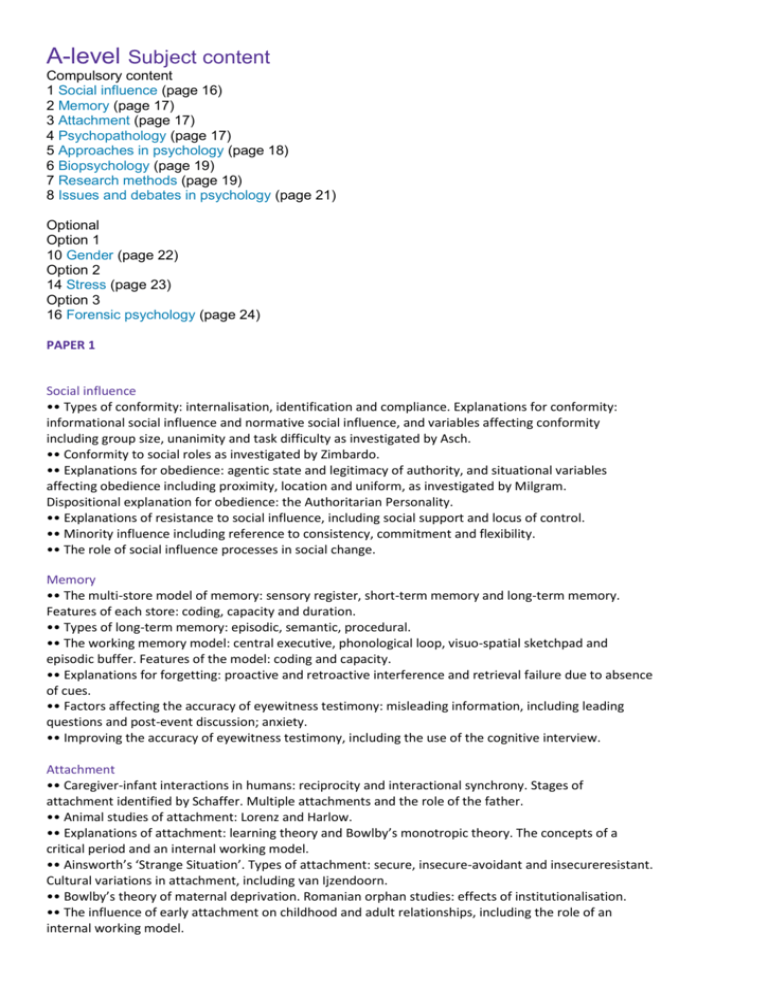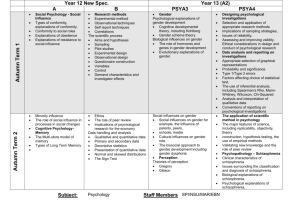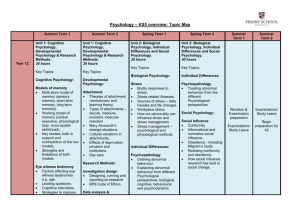File
advertisement

A-level Subject content Compulsory content 1 Social influence (page 16) 2 Memory (page 17) 3 Attachment (page 17) 4 Psychopathology (page 17) 5 Approaches in psychology (page 18) 6 Biopsychology (page 19) 7 Research methods (page 19) 8 Issues and debates in psychology (page 21) Optional Option 1 10 Gender (page 22) Option 2 14 Stress (page 23) Option 3 16 Forensic psychology (page 24) PAPER 1 Social influence •• Types of conformity: internalisation, identification and compliance. Explanations for conformity: informational social influence and normative social influence, and variables affecting conformity including group size, unanimity and task difficulty as investigated by Asch. •• Conformity to social roles as investigated by Zimbardo. •• Explanations for obedience: agentic state and legitimacy of authority, and situational variables affecting obedience including proximity, location and uniform, as investigated by Milgram. Dispositional explanation for obedience: the Authoritarian Personality. •• Explanations of resistance to social influence, including social support and locus of control. •• Minority influence including reference to consistency, commitment and flexibility. •• The role of social influence processes in social change. Memory •• The multi-store model of memory: sensory register, short-term memory and long-term memory. Features of each store: coding, capacity and duration. •• Types of long-term memory: episodic, semantic, procedural. •• The working memory model: central executive, phonological loop, visuo-spatial sketchpad and episodic buffer. Features of the model: coding and capacity. •• Explanations for forgetting: proactive and retroactive interference and retrieval failure due to absence of cues. •• Factors affecting the accuracy of eyewitness testimony: misleading information, including leading questions and post-event discussion; anxiety. •• Improving the accuracy of eyewitness testimony, including the use of the cognitive interview. Attachment •• Caregiver-infant interactions in humans: reciprocity and interactional synchrony. Stages of attachment identified by Schaffer. Multiple attachments and the role of the father. •• Animal studies of attachment: Lorenz and Harlow. •• Explanations of attachment: learning theory and Bowlby’s monotropic theory. The concepts of a critical period and an internal working model. •• Ainsworth’s ‘Strange Situation’. Types of attachment: secure, insecure-avoidant and insecureresistant. Cultural variations in attachment, including van Ijzendoorn. •• Bowlby’s theory of maternal deprivation. Romanian orphan studies: effects of institutionalisation. •• The influence of early attachment on childhood and adult relationships, including the role of an internal working model. Psychopathology •• Definitions of abnormality, including deviation from social norms, failure to function adequately, statistical infrequency and deviation from ideal mental health. •• The behavioural, emotional and cognitive characteristics of phobias, depression and obsessivecompulsive disorder (OCD). •• The behavioural approach to explaining and treating phobias: the two-process model, including classical and operant conditioning; systematic desensitisation, including relaxation and use of hierarchy; flooding. •• The cognitive approach to explaining and treating depression: Beck’s negative triad and Ellis’s ABC model; cognitive behaviour therapy (CBT), including challenging irrational thoughts. •• The biological approach to explaining and treating OCD: genetic and neural explanations; drug therapy. PAPER 2 Approaches in psychology Origins of psychology: Wundt, introspection and the emergence of psychology as a science. The basic assumptions of the following approaches: •• Learning approaches: the behaviourist approach, including classical conditioning and Pavlov’s research, operant conditioning, types of reinforcement and Skinner’s research; social learning theory including imitation, identification, modelling, vicarious reinforcement, the role of mediational processes and Bandura’s research. •• The cognitive approach: the study of internal mental processes, the role of schema, the use of theoretical and computer models to explain and make inferences about mental processes. The emergence of cognitive neuroscience. •• The biological approach: the influence of genes, biological structures and neurochemistry on behaviour. Genotype and phenotype, genetic basis of behaviour, evolution and behaviour. •• The psychodynamic approach: the role of the unconscious, the structure of personality, that is ID, ego and superego, defence mechanisms including repression, denial and displacement, psychosexual stages. •• Humanistic psychology: free will, self-actualisation and Maslow’s hierarchy of needs, focus on the self, congruence, the role of conditions of worth. The influence on counselling psychology. •• Comparison of approaches. Biopsychology •• The divisions of the nervous system: central and peripheral (somatic and autonomic). •• The structure and function of sensory, relay and motor neurons. The process of synaptic transmission, including reference to neurotransmitters, excitation and inhibition. •• The function of the endocrine system: glands and hormones. •• The fight or flight response including the role of adrenaline. •• Localisation of function in the brain and hemispheric lateralisation: motor, somatosensory, visual, auditory and language centres; Broca’s and Wernicke’s areas, split brain research. Plasticity and functional recovery of the brain after trauma. •• Ways of studying the brain: scanning techniques, including functional magnetic resonance imaging (fMRI); electroencephalogram (EEGs) and event-related potentials (ERPs); post-mortem examinations. •• Biological rhythms: circadian, infradian and ultradian and the difference between these rhythms. The effect of endogenous pacemakers and exogenous zeitgebers on the sleep/wake cycle. Research methods Students should demonstrate knowledge and understanding of the following research methods, scientific processes and techniques of data handling and analysis, be familiar with their use and be aware of their strengths and limitations. •• Experimental method. Types of experiment, laboratory and field experiments; natural and quasi experiments. •• Observational techniques. Types of observation: naturalistic and controlled observation; covert and overt observation; participant and non-participant observation. •• Self-report techniques. Questionnaires; interviews, structured and unstructured. •• Correlations. Analysis of the relationship between co-variables. The difference between correlations and experiments. •• Content analysis. •• Case studies. Scientific processes •• Aims: stating aims, the difference between aims and hypotheses. •• Hypotheses: directional and non-directional. •• Sampling: the difference between population and sample; sampling techniques including: random, systematic, stratified, opportunity and volunteer; implications of sampling techniques, including bias and generalisation. •• Pilot studies and the aims of piloting. •• Experimental designs: repeated measures, independent groups, matched pairs. •• Observational design: behavioural categories; event sampling; time sampling. •• Questionnaire construction, including use of open and closed questions; design of interviews. •• Variables: manipulation and control of variables, including independent, dependent, extraneous, confounding; operationalisation of variables. •• Control: random allocation and counterbalancing, randomisation and standardisation. •• Demand characteristics and investigator effects. •• Ethics, including the role of the British Psychological Society’s code of ethics; ethical issues in the design and conduct of psychological studies; dealing with ethical issues in research. •• The role of peer review in the scientific process. •• The implications of psychological research for the economy. •• Reliability across all methods of investigation. Ways of assessing reliability: test-retest and interobserver; improving reliability. •• Types of validity across all methods of investigation: face validity, concurrent validity, ecological validity and temporal validity. Assessment of validity. Improving validity. •• Features of science: objectivity and the empirical method; replicability and falsifiability; theory construction and hypothesis testing; paradigms and paradigm shifts. •• Reporting psychological investigations. Sections of a scientific report: abstract, introduction, method, results, discussion and referencing. Data handling and analysis •• Quantitative and qualitative data; the distinction between qualitative and quantitative data collection techniques. •• Primary and secondary data, including meta-analysis. •• Descriptive statistics: measures of central tendency – mean, median, mode; calculation of mean, median and mode; measures of dispersion; range and standard deviation; calculation of range; calculation of percentages; positive, negative and zero correlations. •• Presentation and display of quantitative data: graphs, tables, scattergrams, bar charts, histograms. •• Distributions: normal and skewed distributions; characteristics of normal and skewed distributions. •• Analysis and interpretation of correlation, including correlation coefficients. •• Levels of measurement: nominal, ordinal and interval. •• Content analysis and coding. Thematic analysis. 4.2.3.3 Inferential testing Students should demonstrate knowledge and understanding of inferential testing and be familiar with the use of inferential tests. •• Introduction to statistical testing; the sign test. •• Probability and significance: use of statistical tables and critical values in interpretation of significance; Type I and Type II errors. •• Factors affecting the choice of statistical test, including level of measurement and experimental design. When to use the following tests: Spearman’s rho, Pearson’s r, Wilcoxon, Mann-Whitney, related t-test, unrelated t-test and Chi-Squared test. PAPER 3 Issues and debates in psychology •• Gender and culture in psychology – universality and bias. Gender bias including androcentrism and alpha and beta bias; cultural bias, including ethnocentrism and cultural relativism. •• Free will and determinism: hard determinism and soft determinism; biological, environmental and psychic determinism. The scientific emphasis on causal explanations. •• The nature-nurture debate: the relative importance of heredity and environment in determining behaviour; the interactionist approach. •• Holism and reductionism: levels of explanation in psychology. Biological reductionism and environmental (stimulus-response) reductionism. •• Idiographic and nomothetic approaches to psychological investigation. •• Ethical implications of research studies and theory, including reference to social sensitivity. Gender •• Sex and gender. Sex-role stereotypes. Androgyny and measuring androgyny including the Bem Sex Role Inventory. •• The role of chromosomes and hormones (testosterone, oestrogen and oxytocin) in sex and gender. Atypical sex chromosome patterns: Klinefelter’s syndrome and Turner’s syndrome. •• Cognitive explanations of gender development, Kohlberg’s theory, gender identity, gender stability and gender constancy; gender schema theory. •• Psychodynamic explanation of gender development, Freud’s psychoanalytic theory, Oedipus complex; Electra complex; identification and internalisation. •• Social learning theory as applied to gender development. The influence of culture and media on gender roles. •• Atypical gender development: gender identity disorder; biological and social explanations for gender identity disorder. Stress •• The physiology of stress, including general adaptation syndrome, the hypothalamic pituitary-adrenal system, the sympathomedullary pathway and the role of cortisol. •• The role of stress in illness, including reference to immunosuppression and cardiovascular disorders. •• Sources of stress: life changes and daily hassles. Workplace stress, including the effects of workload and control. •• Measuring stress: self-report scales (Social Readjustment Ratings Scale and Hassles and Uplifts Scale) and physiological measures, including skin conductance response. •• Individual differences in stress: personality types A, B and C and associated behaviours; hardiness, including commitment, challenge and control. •• Managing and coping with stress: drug therapy (benzodiazepines, beta blockers), stress inoculation therapy and biofeedback. Gender differences in coping with stress. The role of social support in coping with stress; types of social support, including instrumental, emotional and esteem support. Forensic psychology •• Problems in defining crime. Ways of measuring crime, including official statistics, victim surveys and offender surveys. •• Offender profiling: the top-down approach, including organised and disorganised types of offender; the bottom-up approach, including investigative Psychology; geographical profiling. •• Biological explanations of offending behaviour: an historical approach (atavistic form); genetics and neural explanations. •• Psychological explanations of offending behaviour: Eysenck’s theory of the criminal personality; cognitive explanations; level of moral reasoning and cognitive distortions, including hostile attribution bias and minimalisation; differential association theory; psychodynamic explanations. •• Dealing with offending behaviour: the aims of custodial sentencing and the psychological effects of custodial sentencing. Recidivism. Behaviour modification in custody. Anger management and restorative justice programmes.






